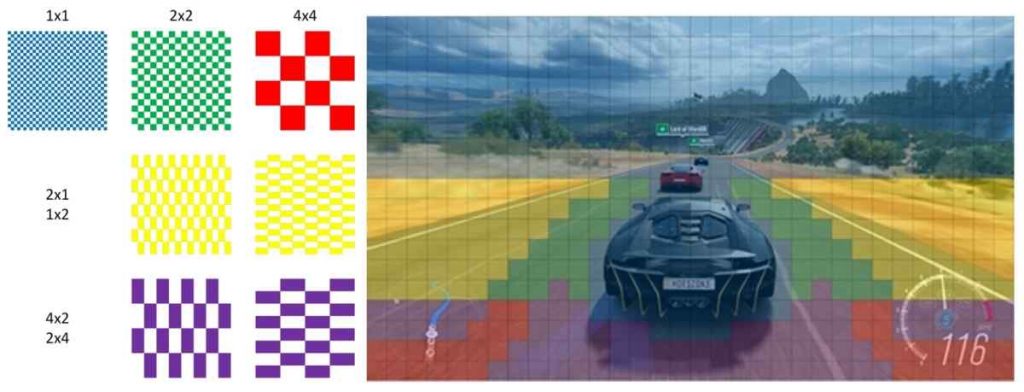Microsoft has made a formal announcement about their newest enhancement to DirectX 12 – DirectX 12 Ultimate. This represents a notable milestone in the evolution of DirectX 12 since its original launch in 2015. A host of new features have been incorporated, with certain aspects having been initially revealed back in October of the preceding year. Although it was initially intended to take the form of Direct3D 12 Feature Levels 12_2, Microsoft has chosen to introduce a rebranded nomenclature, appending the term “Ultimate” to this latest iteration of DirectX 12. The question now arises: What distinguishes this enhanced rendition of DirectX 12, aptly named Ultimate?

Well, after all, the official gave some details about the new features in the blog post, this article will try to interpret it.
First of all, there are four new features in DirectX 12 Ultimate: DirectX Raytracing 1.1, variable rate rendering, Mesh renderer and Sampler Feedback.
DirectX Raytracing 1.1
In 2018, Microsoft introduced a novel addition to DirectX 12 known as DirectX Raytracing (DXR), enabling real-time ray tracing processing. The inaugural iteration, DXR 1.0, possessed rudimentary software attributes and was essentially tailored to harmonize with the hardware specifics of the Turing architecture. However, it neglected the intricacies of implementing light tracing from a software engineering perspective. The subsequent release, DXR 1.1, expands the ray tracing capabilities of DirectX 12 by infusing heightened efficiency and developer-friendliness. This advancement rests on three pivotal enhancements:
Allow GPU to directly call light chase
The shader running on the GPU can call ray tracing directly in version 1.1 without calling back the CPU. This feature is very useful for adaptive ray tracing scenes, especially in culling, sorting, classification, and thinning based on shaders. Basically, future ray tracing work can be prepared on the GPU and generated immediately.
Load raytraced shaders on demand
When the player moves in the game world and new objects become visible, the streaming engine can load new ray-tracing shaders according to the picture requirements at this time, improving the efficiency of the processing process.
Inline ray tracing
Inline raytracing is an alternative form of ray tracing based on dynamic shaders. You can understand it as a simplified ray tracing. Developers will have more control during the inline ray tracing process and can call it at any shading stage, including the computation shading and pixel shading stages. It can be mixed with traditional dynamic shader-based ray tracing. For simple scenes, inline ray tracing will provide better performance, while in complex scenes, dynamic shader-based ray tracing will provide better performance. Running effect.
Variable rate coloring
Variable rate shading (VRS) represents an accelerated shading technique that made its debut through NVIDIA’s Turing GPU. To delve into its finer points, refer to our comprehensive article titled “Super Class (212): Enhancing Frame Rates with VRS Variable Rate Shading.” In a nutshell, the underlying concept of VRS involves modulating the shading precision across distinct screen regions by altering the pixel count processed within a singular pixel shader operation. This essentially permits the adjustment of rendering intricacy for discrete segments of a unified image, ultimately culminating in augmented frame rates.

When VRS is not turned on, that is, under normal circumstances, all pixels of a frame are independently colored. After VRS is turned on, the original independent pixels are divided into pixel blocks, and they will share the colouring result. At this time, The GPU assigns different shading fineness to all pixel blocks according to the importance ranking set by the programmer. Take the above picture as an example, the pixels of the vehicle and the vision part are still independently colored, but the pixel blocks of the fast-moving road and roadside are co-colored. At this time, the computing resources of the graphics card are saved, so the game The number of frames will increase.
Outside of NVIDIA, Intel has added support for VRS to the 11th generation of graphics in the Ice Lake processor, while AMD has no related support for the time being. Still, they have also announced that they will add relevant support to the RDNA 2 architecture.
Mesh shaders: the foundation of the next-generation geometry processing pipeline
In the past two decades, the traditional geometry processing pipeline has been increased by several stages, but its core concept is still based on the traditional rasterization pre-colouring method, which is too complicated today and will slow down processing efficiency. Both hardware and software developers want to change this situation, so DirectX 12 introduced the Mesh shader, which provides developers with unprecedented programmability.

In the original pipeline, the parallelism of the GPU hardware was hidden, or it was automated. The hardware will help package the operation and then execute it in parallel. This is very efficient, but it also has problems-it is not flexible enough.
The Mesh shader completely changes this process. It is no longer a single function for a single vertex or primitive but works in the entire group of computing threads. In one stage, each thread of the Mesh shader is directed to a vertex, and in the other stage, each thread is directed to a primitive. The memory of the entire thread group is shared, and the access flexibility is very high. At the same time, the developer has greater control over the hardware. It can even inspire new technologies and save memory usage and memory bandwidth.
Along with the Mesh shader, there is also an optional Amplification Shader stage, which runs before the Mesh shader, calculates how many Mesh shaders are needed, and starts them.
Sampler feedback
The last big feature is Sampler Feedback. Let me talk about the effect first: better visual quality, shorter loading time, and less stuttering. Its core idea is actually to let the program load only the necessary textures, and hand over resources to where they are needed more.
Sampler feedback is to allow the game engine to track the use of the texture sampler and let the latter provide feedback to the engine. The method is to generate a “Feedback Map”, which records the different resident levels of different texture regions, and then the program You can use this feedback to make decisions—including how to use the texture sampler and what resources to keep in video memory. This is more accurate than the original process and allows better allocation of computing resources. Simply put, the practical effect is to render larger, more detailed textures with less video memory.
In addition, sampler feedback allows a new technique-texture space shading. It can perform object shading without rasterizing the object, and its central purpose is to cache and reuse the shading results, reducing the calculation amount of the GPU.
Summary: Targeting New Graphics Architectures and Next Generation Hosts
Upon the introduction of DirectX 12 Ultimate by Microsoft, swift endorsements from both NVIDIA and AMD followed suit. Evidently, a significant proportion of the novel attributes within DirectX 12 Ultimate can be traced back to the foundation laid by the Turing architecture, hinting at NVIDIA’s prescient foresight during the inception of the Turing design. While NVIDIA seems to have retained some features under wraps, AMD presently assumes a role akin to an observer, playing catch-up to integrate these innovations within the RDNA 2 architecture.
These collective features within DirectX 12 Ultimate manifest two overarching objectives: the enhancement of developer command over hardware intricacies and the amplification of overall computational efficiency. This augmentation aligns with the impending console generation, embodied by the Xbox Series X and the illustrious Xbox Series S. The timeline for the practical integration of these features into actual games remains uncertain, potentially extending beyond the current year.
The implementation necessitates the synchronization of engine developers and game creators, either through a tailored adaptation to the new console generation or specialized development endeavors. As such, the realization of these technologies in PC games remains contingent upon these preparatory phases.
Stay tuned to BreakinGameNews.COM for the latest updates and content drop news.




